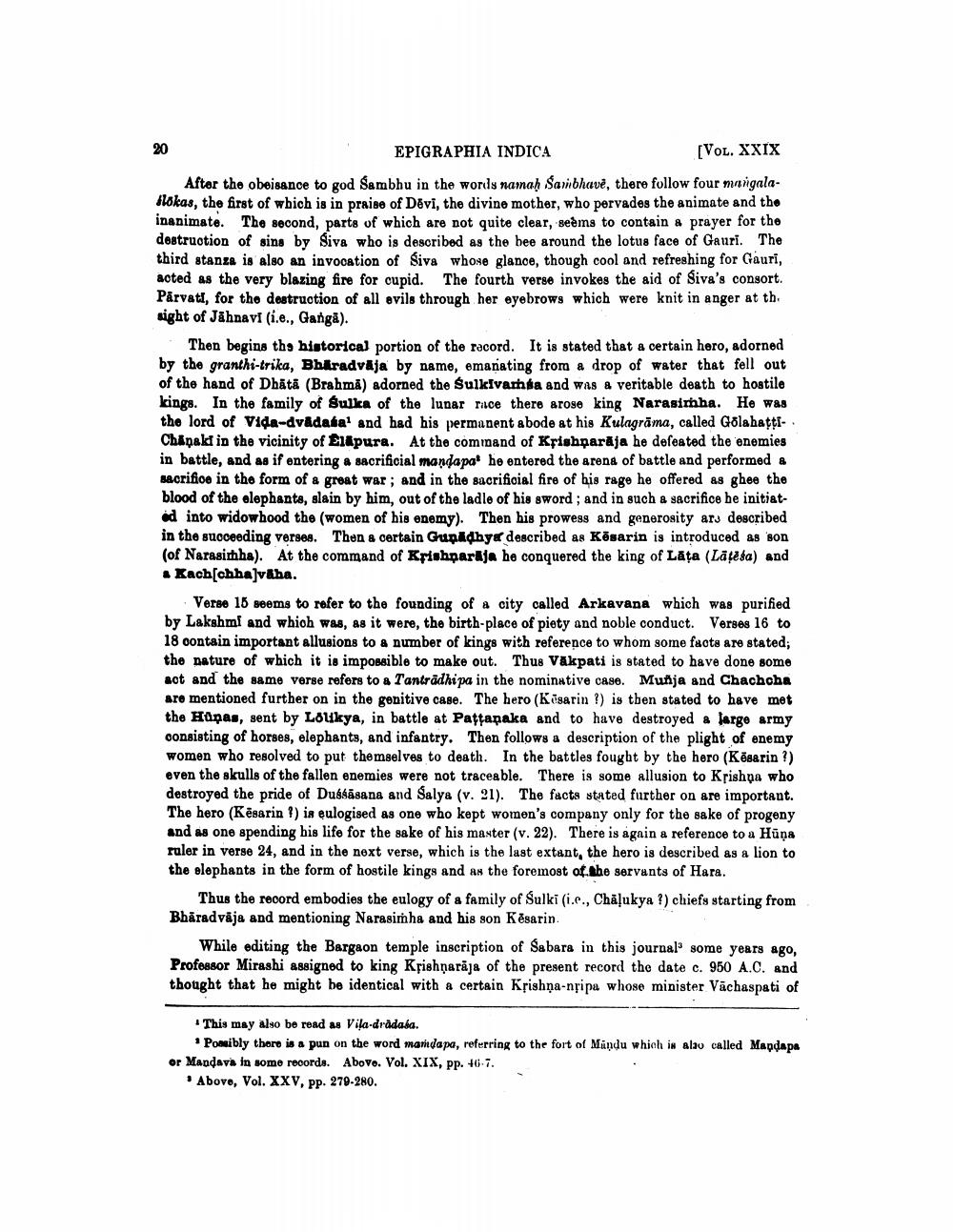________________
EPIGRAPHIA INDICA
[VOL. XXIX
After the obeisance to god Sambhu in the words namah Sabhave, there follow four mangalaFlokas, the first of which is in praise of Davi, the divine mother, who pervades the animate and the inanimate. The second, parts of which are not quite clear, seems to contain a prayer for the destruction of sins by Siva who is described as the bee around the lotus face of Gauri. The third stanza is also an invocation of Siva whose glance, though cool and refreshing for Gauri, acted as the very blazing fire for cupid. The fourth verse invokes the aid of Siva's consort. Parvati, for the destruction of all evils through her eyebrows which were knit in anger at th. sight of Jāhnavi (1.e., Ganga).
Then begins the historical portion of the racord. It is stated that a certain hero, adorned by the granthi-trika, Bharadvaja by name, emanating from a drop of water that fell out of the hand of Dhātá (Brahma) adorned the sulkivata and was & veritable death to hostile kings. In the family of Sulka of the lunar race there arose king Narasimha. He was the lord of Vida-dvådaial and had his permanent abode at his Kulagrāma, called Golahatti- . Chanell in the vicinity of Elkpura. At the command of Krishparaja he defeated the enemies in battle, and as if entering a sacrificial mandapat he entered the arena of battle and performed & sacrifice in the form of a great war; and in the sacrificial fire of his rage he offered as ghee the blood of the elephants, slain by him, out of the ladle of his sword; and in such a sacrifice he initiated into widowhood the (women of his enemy). Then his prowess and generosity ars described in the succeeding verses. Then & certain Grup dhy« described as Kösarin is introduced as son (of Narasimhha). At the command of Krishnaraja he conquered the king of Lata (Lätasa) and • Kachchha]váha.
Verse 15 seems to refer to the founding of a city called Arkavana which was purified by Lakshmi and which was, as it were, the birth-place of piety and noble conduct. Verses 16 to 18 contain important allusions to a number of kings with reference to whom some facts are stated; the nature of which it is impossible to make out. Thus Vakpati is stated to have done some act and the same verse refers to a Tantrādhi pa in the nominative case. Munja and Chachcha are mentioned further on in the genitive case. The hero (Kisarin ?) is then stated to have met the Hapas, sent by Loukya, in battle at Pattanaka and to have destroyed a large army consisting of horses, elephants, and infantry. Then follows a description of the plight of enemy women who resolved to put themselves to death. In the battles fought by the hero (Kësarin ?) even the skulls of the fallen enemies were not traceable. There is some allusion to Krishňa who destroyed the pride of Dussāsana and Salya (v. 21). The facts stated further on are important. The hero (Kēsarin ?) in eulogised as one who kept women's company only for the sake of progeny and as one spending his life for the sake of his master (v. 22). There is again a reference to a Hūņa ruler in verse 24, and in the next verse, which is the last extant, the hero is described as a lion to the elephants in the form of hostile kings and as the foremost of Bhe servants of Hara.
Thus the record embodies the eulogy of a family of Sulki (i.c., Chäļukya ?) chiefs starting from Bhäradvaja and mentioning Narasimha and his son Kesarin
While editing the Bargaon temple inscription of Sabara in this journal some years ago, Professor Mirashi assigned to king Krishnarāja of the present record the date c. 950 A.C. and thought that he might be identical with a certain Krishna-nțipa whose minister Vāchaspati of
This may also be read as Vila-drädala.
* Possibly there is a pun on the word mandapa, referring to the fort of Mündu which in alao called Mandapa or Mandava in some records. Abovo. Vol. XIX, pp. 46.7.
. Above, Vol. XXV, pp. 279-280.




